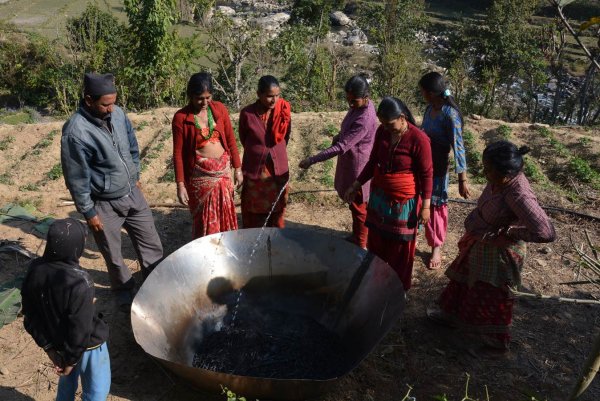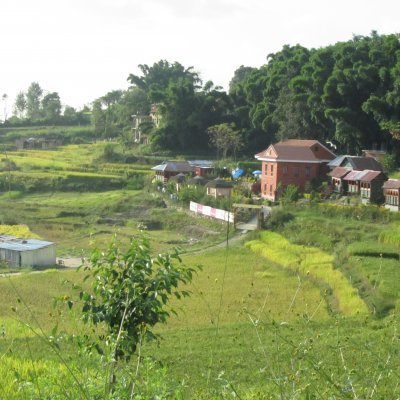Farmers test a green growth technology that could transform agricultural production in Nepal
Green growth and climate resilient development – these goals were not foremost in the minds of pumpkin farmers in Nalang Village, Dhading District when they agreed to join field trials for producing and applying their own organic fertilizer. Like so many Nepalese women and men who depend on farming for their livelihoods, their top concern was getting high crop yields while lowering their input costs. But this group of eight women and two men are now showing how boosting agriculture productivity and saving costs at the farm level can go hand in hand with addressing priorities identified in Nepal’s national climate change strategies.
Farmers in Nalang and 14 other villages are participating in farm-based field trials that are testing biochar based organic fertilizer as an alternative to chemical fertilizers in different climate zones and soil types of Nepal. The field trials are being run by the Ministry of Agricultural Development under the Asian Development Bank technical assistance Sustainable Rural Ecology for Green Growth, a component of the project Mainstreaming Climate Change Risk Management in Development (part of the Pilot Program for Climate Resilience). The Nordic Development Fund (NDF) is financing this eighteen-month component, which started in June 2014.
Biochar based fertilizer is a new method to improve soil fertility and plant productivity in ways that enhance the ability of crops to withstand climate impacts, and at the same time reduce carbon-intensive agricultural inputs. Biochar is made from crop residues, shrubs and animal feed leftovers. While not in itself a fertilizer, biochar is a highly porous carrier material that, like a sponge, soaks up organic nutrients (e.g. from animal urine) and makes them available to plants.
Biochar contributes to reducing greenhouse gases in three ways. First, the production of biochar means farmers do not burn crop wastes, thereby reducing carbon emission. Second, biochar does not decompose when applied to soil and so becomes a long-term carbon sink. And third, the technique replaces mineral fertilizers with organic waste liquids that would otherwise flow unused to the rivers and groundwater. This use of organic waste liquids reduces emissions of nitrous oxide, a greenhouse gas that produces a climate change impact 300 times higher than that of carbon dioxide. All together, one ton of organic biochar fertilizer can reduce the equivalent of 4 tons of carbon dioxide.
The biochar method enhances the nutrient efficiency in fertilization and makes crops more resilient to dry conditions. The trials have found that the combination of biochar and cow urine – a source of nutrients readily available to farmers – may massively improve crop yields. The increase of soil organic matter in the root zone of crops resulting from biochar use, reduces erosion, and enhances the soil’s water holding and infiltration capacity. (See Facts about biochar below, for more details on the reasons for developing biochar fertilizer and how it works.)
The Sustainable Rural Ecology for Green Growth technical assistance is documenting Nepal specific evidence of the positive impacts of biochar and testing the most effective ways to produce biochar for different soil and agro-ecological conditions. The technical assistance will also collect data to estimate the possible reduction in greenhouse gas (nitrous oxide N20and methane CH4) emissions and the amount of direct capture and storage of carbon in the soil. This information will be used by the Ministry of Agricultural Development to plan programs to scale-up application of this climate-smart technology. Dr. Suroj Pokhrel, Joint Secretary of the Ministry of Agricultural Development recently visited project villages to see for himself how this new technique was working. Speaking with farmers about the results, Dr. Pokhrel affirmed, “Replacing chemical fertilizer with urine-biochar technology has been very effective and needs to be promoted at a wider level.”
For Sita Lamsal, one of the women participating in the trials, the benefits are clear. “Since the price for fertilizer has massively increased, we are very happy that we now know how to make our fertilizer for free!” she explains. Ambika Aryal, another trial participant, has seen her yield double. Ms. Aryal earned $350 from her farm 100m2 plot, an important contribution to her family’s annual income. “We need to share the results with other farmers,” says Ms. Aryal.
As the trials are completed, the Ministry of Agricultural Development and the technical assistance team is sharing the results and methods with other farmers in Nepal. Dissemination and farmer-to-farmer exchange workshops were organized in several of the project villages. The project plans to extend these farmer-to-farmer exchanges to other regions.
The TA is also producing a series of knowledge products including a report that details options, specifications and implementation methodology for biochar development, a bio-brief, peer reviewed scientific papers, and a national workshop, that will ensure the results feedback to the various stakeholders. These knowledge products will also be disseminated online for international stakeholders as part of global efforts to develop biochar as a climate resilient, green growth technique that brings tangible benefits to farmers.
FACTS ABOUT BIOCHAR
What is biochar?
Biochar is a very porous, charcoal like material that can be produced from all types of biomasses like maize and crop residues, rice husks, shrubs, and animal feed leftovers. Well-prepared biochar has a surface area of more than 300 m2 per gram and can hold up to 6 times its own weight of water. When such biochar is mixed with liquid organic nutrients like animal manure or urine, the inner surfaces of this porous material get coated with complex organic nutrients. Like a sponge the biochar soaks up the nutrients and becomes a highly efficient fertilizer.
When these biochar-based fertilizers are then applied close to crop roots, the plants can take up the nutrients as needed in their respective growth stage. Biochar holds the nutrients strongly in place in the root zone and will not leach out even in the case of strong rain events.
Thanks to this combination of biochar and liquid organic nutrients applied into the root zone, the organic biochar-fertilizer promotes growth in the same way as conventional chemical fertilizer and with the right formulation and application can produce even higher yields.
Why introduce biochar to Nepal’s farmers?
During the last 10 years, the application of chemical and mineral fertilizers became a more and more common practice in Nepali agriculture. While this practice produced initial yield increases compared to the traditional fertilizing practice, it brought with it negative ecological and economical effects such as:
-
A decrease in soil organic mater with long-term soil fertility degrading effects
-
Leaching of fertilizers into ground- and surface water causing contamination of drinking water and eutrophication of rivers and lakes.
-
Crops become more sensitive to pests requiring pesticide applications
-
Massive increase of green house gases. As each ton of mineral nitrogen fertilizer consumes the equivalent of 10 tons of carbon dioxide (CO2), average mineral fertilization causes up to 5 tons of carbon dioxide equivalent emissions per hectare.
-
Farmlands in the Terai and Kathmandu valley where chemical fertilization is a common practice for the last few decades are already showing a massive decrease in soil fertility and soil organic matter. Those degraded soils are more exposed to erosion and drought, creating greater risk of crop failure from extreme climate events. Biochar has the potential to improve soil quality at low cost to farmers while at the same time providing a valuable ecological service.
How is biochar made?
During the trials farmers learn how to produce biochar in a cost-efficient soil kiln. The project further supported the construction of animal urine recovery pits. The biochar is placed in these pits to soak up cow urine. After some days of fermentation the biochar-urine blend becomes a NK fertilizer containing 10 kg of nitrogen and of potassium per m3 of biochar. A farmer who owns two cows can produce 7 to 10 m3 of organic biochar-fertilizer. This yearly amount of organic fertilizer contains 120 kg of nitrogen with a value of more than 10,000 NRP, sufficient for the annual fertilization of half a hectare, the average field size of a Nepali farm.
The project helped the farmers to set-up field trials with different biochar-fertilizer formulations to test and see the efficiency of the different treatments. The biochar was thus either applied alone or mixed with fresh cow urine (1:1 vol) to demonstrate its capacity to serve as slow release fertilizer. In a pumpkin field trial, treatments included cow-manure compost combined with (i) urine-only; (ii) biochar-only or (iii) urine-loaded biochar. All formulations were applied directly to the root zone before seeding.
The urine-biochar treatment led to a pumpkin yield of 82.6 tons per hectare, which was a fourfold yield increase compared with the traditional practice where only urine and compost was applied as fertilizer, and a doubling compared with the biochar-only treatment. This farmer trial demonstrated that a low-dosage root zone application of urine-enhanced biochar led to substantial yield increases in a typical fertile silt loam soil of Nepal.
What are the implications of the biochar field trials for the agricultural sector in Nepal?
The pumpkin yields obtained in the urine-biochar treatments exceeded even those of optimized conventional farming with chemical fertilizer and irrigation. The trials demonstrated that organic enhancement of biochar combined with concentrated root zone application can improve plant nutrition and hence crop productivity while reducing farmer’s expenses for fertilizer. The farmer trial in Nalang Village, Dhading District confirmed results from the other 14 project villages where the biochar-urine technology consistently showed that mineral chemical fertilizer can be replaced by farm-made organic fertilizer without any yield decrease and in most cases with substantial yield increases. Complete or partial replacing of mineral fertilizer through highly efficient organic fertilizer will reduce greenhouse gas emissions, will contribute to improved soil quality and more climate resilient crop production and will improve the economics of food production in Nepali farming.
NDF wants to acknowledge that the authorship of the news item is assigned to TA 7984 Mainstreaming Climate Change Risk Management in Development. Ministry of Population and Environment (MOPE) and Ministry of Agricultural Development are the executing agencies of the project.


